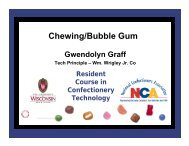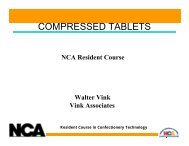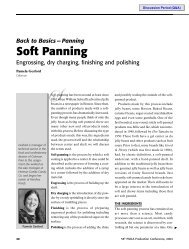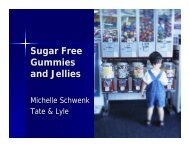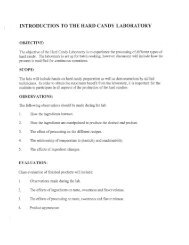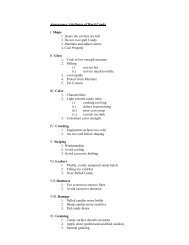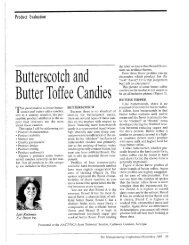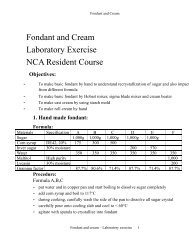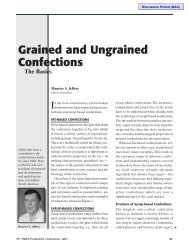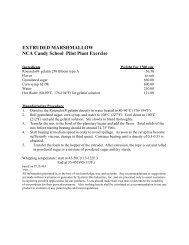2003 Caramel--Raw Materials and Formulations - staging.files.cms ...
2003 Caramel--Raw Materials and Formulations - staging.files.cms ...
2003 Caramel--Raw Materials and Formulations - staging.files.cms ...
Create successful ePaper yourself
Turn your PDF publications into a flip-book with our unique Google optimized e-Paper software.
<strong>Caramel</strong> — <strong>Raw</strong> <strong>Materials</strong> <strong>and</strong> <strong>Formulations</strong><br />
So many things<br />
about the milk can<br />
have an effect. The<br />
differences in the<br />
raw milk itself, how<br />
it was processed,<br />
stored <strong>and</strong><br />
reconstituted, all<br />
have their effect,<br />
mostly due to<br />
protein quality.<br />
Breakdown of Sweetened Condensed<br />
Whole Milk<br />
Scwm . . . . . . . . . . . . . . . . . . . . . . . . . . . . . . . 312.0 g<br />
Sucrose (61.1% dry, 44.0% wet) . . . . . 137.3 g<br />
Butterfat (11.8% dry, 8.5% wet) . . . . . . . 26.5 g<br />
Lactose (14.6% dry, 10.5% wet) . . . . . . . 32.8 g<br />
Protein (12.5% dry, 9.0% wet) . . . . . . . . 28.1 g<br />
Water (28% wet) . . . . . . . . . . . . . . . . . . . . . 87.3 g<br />
Figure 4<br />
the sugar, fat, lactose, total protein <strong>and</strong><br />
water levels.The numbers again are examples<br />
(Figure 4).<br />
Look at the sugar in the scwm, it’s<br />
almost a quarter of all the sucrose in the<br />
caramel recipe <strong>and</strong> most of the solids of the<br />
ingredient. Remember to check with your<br />
supplier for exact numbers.<br />
There are many other forms of milk that<br />
can be used or even different components<br />
from milk such as just adding casein or<br />
whey.The casein mostly affects texture by<br />
adding body <strong>and</strong> the whey proteins add<br />
color <strong>and</strong> flavor.They could be used to cut<br />
costs or modify your texture or flavor.<br />
Again, break them down, for example, for<br />
the lactose usually found in the whey. If<br />
adding more casein or whey, break down<br />
the protein above so you know how much<br />
you’re starting with.<br />
So many things about the milk can<br />
have an effect. The differences in the raw<br />
milk itself, how it was processed, stored<br />
<strong>and</strong> reconstituted, all have their effect,<br />
mostly due to protein quality. You need to<br />
find which of the differences will affect<br />
your caramel <strong>and</strong> then you need to control<br />
them.<br />
Partially hydrogenated vegetable fat —<br />
184.0 g We won’t break the fat down, but<br />
here are the critical numbers of the fat:<br />
• The melt point — the higher the melt<br />
point, the better the st<strong>and</strong>-up, but be<br />
careful going above 92°–95°F as it can<br />
start to give it a waxy texture <strong>and</strong> flavor.<br />
• The solid fat index (sfi)—this will let<br />
you know how sharp a melt curve you<br />
will have. This can influence the flavor<br />
release.<br />
Other factors in deciding are resistance to<br />
oxidation <strong>and</strong> even how the fats are added.<br />
Blending several fats before emulsification<br />
can yield overall softer fats due to<br />
eutectic effect.<br />
Salt — 14.0 g The salt is used primarily to<br />
enhance flavor.<br />
Soy lecithin — 2.5 g The soy lecithin is an<br />
emulsifier, ensuring a good dispersion<br />
<strong>and</strong> homogenization of the fat. Other<br />
emulsifiers can be used to help with specific<br />
needs of your caramel. For example,<br />
gms can be used to help with st<strong>and</strong>-up<br />
or to help with cutting a caramel that is<br />
sticky. Talk to your suppliers to determine<br />
which are best for your needs. Don’t<br />
forget that the milk proteins also help in<br />
emulsification <strong>and</strong> in some cases may be<br />
all you need. Just make sure you have the<br />
level <strong>and</strong> type of emulsifier correct. If too<br />
much, you’re wasting money <strong>and</strong> it could<br />
even contribute to off flavor or texture<br />
<strong>and</strong> if too little, it could oil out.<br />
Other ingredients It is common to use carbonates,<br />
phosphates or other buffers to<br />
adjust the pH of your caramel. If the pH is<br />
too low, below the isoelectric point of the<br />
milk proteins (~4.6), the proteins will precipitate.As<br />
the pH rises, you affect the rate<br />
of the Maillard reaction, but if it is too high<br />
your flavor quality decreases.A good starting<br />
point is a pH between 6 <strong>and</strong> 6.5.<br />
You can use other ingredients to modify<br />
texture <strong>and</strong> flavor, such as various nutmeats<br />
<strong>and</strong> vanilla or vanillin. Starches or<br />
other thickeners can be used to modify<br />
product texture <strong>and</strong> your process.<br />
Putting it all Together<br />
Now rewrite your recipe <strong>and</strong> turn it into<br />
a formula. Our recipe turns into Figure 5. ➤<br />
26 57 th PMCA Production Conference, <strong>2003</strong>



